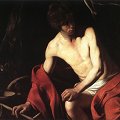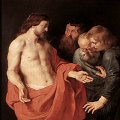Baroque
 1600 -
1700.
1600 -
1700.  Baroque Art developed in Europe as an
reaction against the intricate and formulaic Mannerism. The Baroque
style used exaggerated motion and clear, easily interpreted detail to
produce drama, tension, exuberance, and grandeur in sculpture and
painting. Baroque art is less complex, more realistic and more
emotionally affecting than Mannerist art. This movement was encouraged
by the Catholic Church, the most important patron of the arts at that
time, being seen as a return to tradition and spirituality. One of the
great periods of art history, Baroque Art was developed by Caravaggio, Gianlorenzo Bernini and Annibale Carracci,
among others. This was also the age of Peter Paul Rubens, Rembrandt van Rijn, Vermeer
and Velazquez.
Baroque Art developed in Europe as an
reaction against the intricate and formulaic Mannerism. The Baroque
style used exaggerated motion and clear, easily interpreted detail to
produce drama, tension, exuberance, and grandeur in sculpture and
painting. Baroque art is less complex, more realistic and more
emotionally affecting than Mannerist art. This movement was encouraged
by the Catholic Church, the most important patron of the arts at that
time, being seen as a return to tradition and spirituality. One of the
great periods of art history, Baroque Art was developed by Caravaggio, Gianlorenzo Bernini and Annibale Carracci,
among others. This was also the age of Peter Paul Rubens, Rembrandt van Rijn, Vermeer
and Velazquez.
Artists and Articles
Caravaggio
 Caravaggio is an Italian painter whose
revolutionary technique of tenebrism, or dramatic, selective
illumination of form out of deep shadow, became a hallmark of Baroque
painting. Scorning the traditional idealized interpretation of
religious subjects, he took his models from the streets and painted
them realistically. His use of models from the lower classes of
society in his early secular works and later religious compositions
appealed to the taste for realism, simplicity, and piety in art.
Equally important is his introduction of dramatic light-and-dark
effects - termed chiaroscuro - into his works. Many Caravaggio's
religious works feature violent struggles, grotesque decapitations,
torture and death. Caravaggio was a "wild" and violent painter
- screams of terror assume a prominent place in many of Caravaggio's
works. The wildness of his personality exploded into his art.
Caravaggio is an Italian painter whose
revolutionary technique of tenebrism, or dramatic, selective
illumination of form out of deep shadow, became a hallmark of Baroque
painting. Scorning the traditional idealized interpretation of
religious subjects, he took his models from the streets and painted
them realistically. His use of models from the lower classes of
society in his early secular works and later religious compositions
appealed to the taste for realism, simplicity, and piety in art.
Equally important is his introduction of dramatic light-and-dark
effects - termed chiaroscuro - into his works. Many Caravaggio's
religious works feature violent struggles, grotesque decapitations,
torture and death. Caravaggio was a "wild" and violent painter
- screams of terror assume a prominent place in many of Caravaggio's
works. The wildness of his personality exploded into his art.
 Judith Beheading Holofernes (1598)
© Caravaggio
Judith Beheading Holofernes (1598)
© Caravaggio
 The Cardsharps (1596)
© Caravaggio
The Cardsharps (1596)
© Caravaggio
 The Sacrifice of Isaac (1605)
© Caravaggio
The Sacrifice of Isaac (1605)
© Caravaggio
- Caravaggio Art, $25
 (100 pictures)
(100 pictures)
- Caravaggio. Art and life. Biography.
- Caravaggio. Early paintings by Caravaggio.
- Caravaggio. Late paintings by Caravaggio.
Peter Paul Rubens
 The Flemish and European Baroque painter Peter Paul Rubens was the most renowned northern European
artist of his day, and is now widely recognized as one of the foremost
painters in Western art history. He was the proponent of the Baroque
style which emphasized movement, color, and
sensuality. By completing the fusion of the realistic tradition
of Flemish painting with the imaginative freedom and classical themes
of Italian Renaissance painting, he fundamentally
revitalized and redirected northern European painting. Rubens was one
of the most methodically assimilative and most prodigiously productive
of Western artists. His abundant energy fired him to study and emulate
the masters both of antiquity and of the 16th century in Rome, Venice,
and Parma. His warmth of nature made him responsive to the artistic
revolutions being worked by living artists, and robust powers of
comprehension nourished his limitless resource in invention. He was
able to infuse his own astounding vitality equally into religious and
mythological paintings, portraits, and landscapes. He organized his
complex compositions in vivid, dynamic designs in which limitations of
form and contour are discounted in favour of a constant flow of
movement.
The Flemish and European Baroque painter Peter Paul Rubens was the most renowned northern European
artist of his day, and is now widely recognized as one of the foremost
painters in Western art history. He was the proponent of the Baroque
style which emphasized movement, color, and
sensuality. By completing the fusion of the realistic tradition
of Flemish painting with the imaginative freedom and classical themes
of Italian Renaissance painting, he fundamentally
revitalized and redirected northern European painting. Rubens was one
of the most methodically assimilative and most prodigiously productive
of Western artists. His abundant energy fired him to study and emulate
the masters both of antiquity and of the 16th century in Rome, Venice,
and Parma. His warmth of nature made him responsive to the artistic
revolutions being worked by living artists, and robust powers of
comprehension nourished his limitless resource in invention. He was
able to infuse his own astounding vitality equally into religious and
mythological paintings, portraits, and landscapes. He organized his
complex compositions in vivid, dynamic designs in which limitations of
form and contour are discounted in favour of a constant flow of
movement.
 Descent from the Cross (Centre Panel) (1614)
© Peter Paul Rubens
Descent from the Cross (Centre Panel) (1614)
© Peter Paul Rubens
 Christ on the Cross between the Two Thieves (1620)
© Peter Paul Rubens
Christ on the Cross between the Two Thieves (1620)
© Peter Paul Rubens
 Portrait of a Young Scholar (1597)
© Peter Paul Rubens
Portrait of a Young Scholar (1597)
© Peter Paul Rubens
- Peter Paul Rubens Art, $29
 (200 pictures)
(200 pictures)
- Peter Paul Rubens. Art and life. Biography.
- Peter Paul Rubens. Early mythological paintings.
- Peter Paul Rubens. Late mythological paintings.
- Peter Paul Rubens. Early religious paintings.
- Peter Paul Rubens. Late religious paintings.
- Peter Paul Rubens. Portraits.
- Peter Paul Rubens. Landscapes.
Rembrandt van Rijn
 Rembrandt van Rijn is generally considered one of
the greatest painters in European art history and the most important
painter in Dutch history. Rembrandt is known as a painter of light and
shade and as an artist who favoured an uncompromising realism.
Rembrandt possessed an exceptional ability to render people in their
various moods and dramatic guises. No artist ever combined more
delicate skill with more energy and power. In all, Rembrandt produced
over 600 paintings, 300 etchings, and 2,000 drawings. He was a
prolific painter of self-portraits, producing almost a hundred of them
throughout his long career. Together they give a remarkably clear
picture of the man, his appearance, and - more importantly - his
deeper being, as revealed by his face. His immediate family, his wife
Saskia, his son Titus, and his common-law wife Hendrickje, often
figured prominently in his paintings. The core of Rembrandt's creative
work, however, consists of biblical and - to a lesser extent -
historical, mythological, and allegorical paintings.
Rembrandt van Rijn is generally considered one of
the greatest painters in European art history and the most important
painter in Dutch history. Rembrandt is known as a painter of light and
shade and as an artist who favoured an uncompromising realism.
Rembrandt possessed an exceptional ability to render people in their
various moods and dramatic guises. No artist ever combined more
delicate skill with more energy and power. In all, Rembrandt produced
over 600 paintings, 300 etchings, and 2,000 drawings. He was a
prolific painter of self-portraits, producing almost a hundred of them
throughout his long career. Together they give a remarkably clear
picture of the man, his appearance, and - more importantly - his
deeper being, as revealed by his face. His immediate family, his wife
Saskia, his son Titus, and his common-law wife Hendrickje, often
figured prominently in his paintings. The core of Rembrandt's creative
work, however, consists of biblical and - to a lesser extent -
historical, mythological, and allegorical paintings.
 Self Portrait In A Gorget (1629)
© Rembrandt van Rijn
Self Portrait In A Gorget (1629)
© Rembrandt van Rijn
 The Jewish Bride (1666)
© Rembrandt van Rijn
The Jewish Bride (1666)
© Rembrandt van Rijn
 The Return of the Prodigal Son (1669)
© Rembrandt van Rijn
The Return of the Prodigal Son (1669)
© Rembrandt van Rijn
- Rembrandt van Rijn Art, $25
 (160 pictures)
(160 pictures)
- Rembrandt van Rijn. Art and life. Biography.
- Rembrandt van Rijn. Self-portraits.
- Rembrandt van Rijn. Greatest works.
More
Movements
 Art Encyclopedia A world history of art in articles.
Art Encyclopedia A world history of art in articles.
Renaissance
Baroque
Romanticism
Impressionism
Postimpressionism
Modernism
Postmodernism
Art
 Art Wallpapers Art image collections for your desktop.
Art Wallpapers Art image collections for your desktop.
